Last Updated on March 3, 2025 by Ellen
Travel guides, blog entries, Airbnb rentals, retirement articles all focus on the tourist destinations on Lake Atitlan. Some villages have far less information about them, like Tzununa and especially San Pablo – where we stayed. If we saw ten tourists in San Pablo passing through the village during our extended stay, that was a lot.
This is the story of what it was like to live near the heart of this Mayan village for one month.
San Pablo la Laguna
Our bungalow
Our rental bungalow was perfect for our four-week stay. It’s a few hundred feet from the main road that turns into the village. It has a gorgeous view of three volcanoes – the largest one directly across from our place is Volcan San Pedro. The well-known tourist village at its base is named after the volcano.
Coffee beans are grown on our rental property and roasted nearby. We enjoyed delicious coffee every morning – better than any coffee we tried in Mexico. Coffee on the porch with an incredible view started our daily routine. Our lives acquired a rhythm somewhat based on the local culture, influenced by life on the lake.
We were generally up with the sun. On Wednesday and Sunday mornings, we went to the village market to stock up on produce. As a woman, I tried to dress more modestly than usual while in the village. Maya women don’t show knees, shoulders, or cleavage. Toes are ok. Half-way through our stay, in the mornings I began to take jogs through the village. A few times, we went on some easy local hikes when the mornings gave us clear weather.
Most of our days were blissfully quiet. We read. We talked. We took in the view. I got in a few books and some news from the U.S. I did some writing. We tried to learn a little more Spanish.
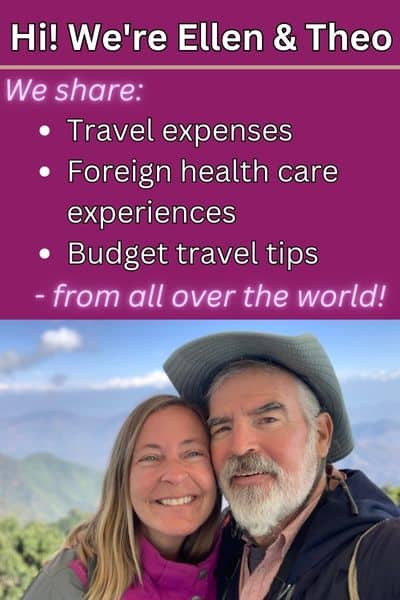
My husband reviewed investments when the wifi was strong enough to surf the internet (which was most days – a wonderful thing!). He took afternoon pictures of birds and bugs and night shots of lightning around the volcano – to practice his macro-photography skills and his patience.
Our time in San Pablo coincided with the start of rainy season. When the sky was clear in the morning, we washed clothes or sheets if needed, hung them outside to dry. There is no laundromat in San Pablo. Families don’t have washing machines. Women hand wash clothes.
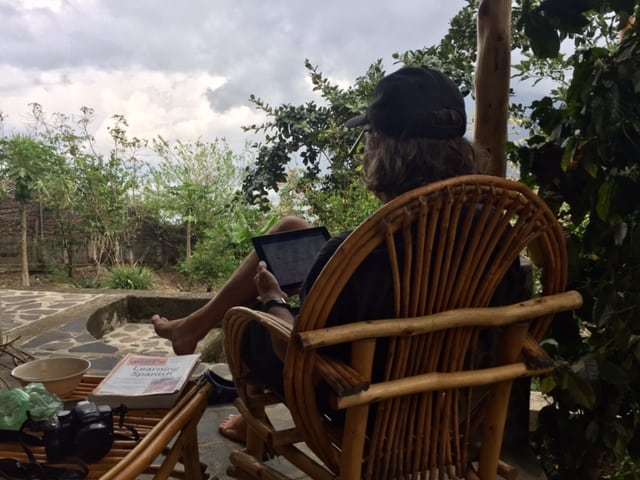
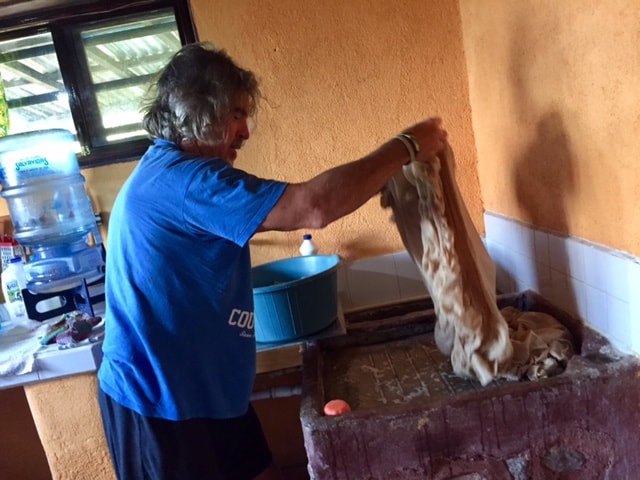
In the village
There is no drug store here, no supermarket, no movie theater, no bookstore, no formal bus station, no beauty shop. Aside from a few street carts with simple food, San Pablo only has one fried chicken restaurant. I never saw anyone dining in.
The village has a small dock used mostly to bring in supplies for sale. We used the dock a couple of miles away in San Marcos when we needed to visit Panajachel or somewhere beyond, because the dock there is larger and more active.
Boats are one way to get from village to village on Lake Atitlan. Some villages are connected easily by a road with varying degrees of small craters. Tuk tuks bounce down these roads. Boats can be faster, and sometimes the only real option, depending on your route and your haul. We only left San Pablo five times in one month.
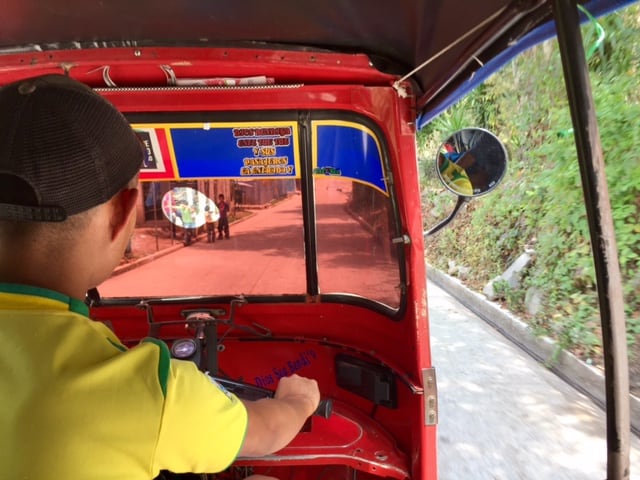
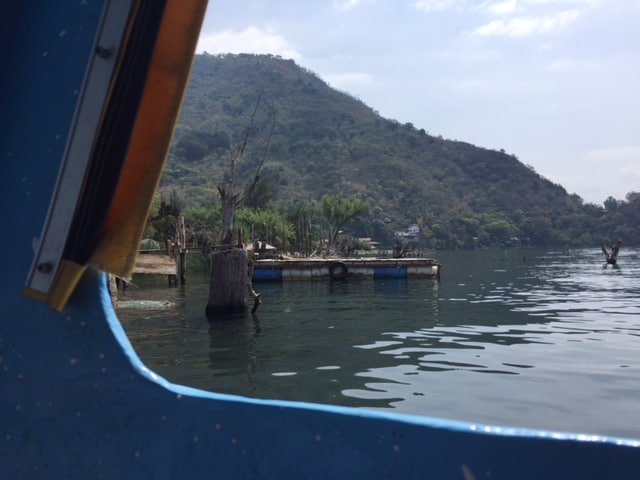
Chicken buses and cars stick to the main road that goes from the far western part of the lake up a mountain and through another town named Santa Clara. That road cuts through a small piece of San Pablo, so only one portion of the road in the village ever has any so-called traditional traffic. Traffic here is something like a bus an hour, a couple of cars an hour, a colectivo (shared taxi ride) now and then. A few delivery trucks from the main road swing by in the mornings.
We met people in the village. We talked with them. Children would yell out “Ola!!” to us every time we passed. After the first week, I knew which children from which homes would try to engage me. I always replied and waved, and asked how they were doing. “Bien, gracias!”
We went to the same tiendas (small stores) for supplies like toilet paper or cereal. We were novelty. Kids gathered around us and giggled with us in the stores. We would tell the shopkeeper to add a few quetzales (Guatemalan currency) to our bill so the children could pick out a piece of candy from a vat on us, ‘the kind Americans.’
One time we heard a band playing and we looked for it on the village streets. When we found it, children were leading women down a hill to a school with a view of the lake. We asked if there would be a concert and if we could watch. A woman warmly told yes. It turned out to be a Mother’s Day ceremony at the school. We found out the holiday is earlier in the week in Guatemala than it is in the U.S.
We were gringos who were interested in their event – interested in their lives. We made small talk outside the schoolyard with children who wanted to chat with us in Spanish. Why did my husband have two pairs of glasses around his neck? What was that dictionary for on my phone? You’re the gringos living in San Pablo!
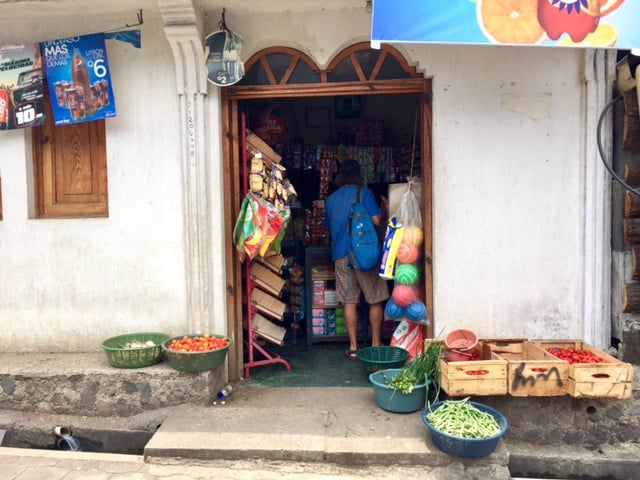
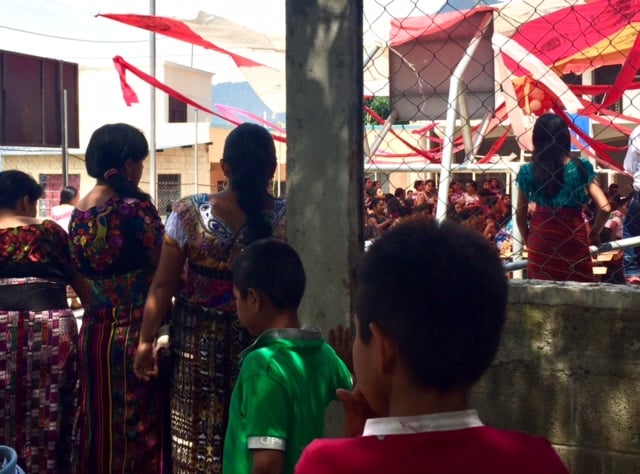
At that young age, school is free for children. At later grades, parents must pay tuition, and cover costs for supplies and transportation and uniforms. This is true of all villages, and in all of Guatemala. This is just another thing we learned about life here during our extended stay.
Typically, locals do not like their pictures taken. Partly for religious reasons, partly from inexperience with digital image collection, partly people are shy. This is why I have so few images of people. The few I do have, I either requested permission first, or I took the photograph in such a way that it was less about the people and more about the scene. Women often told me no, no pictures please.
I have a couple of shots with my spouse and locals facing the camera. One man who sold us wood for our campfire requested the equivalent of a dollar for the privilege of taking his photo. We gave it to him. Another picture is with the older gentleman we often saw walking around the village and on the road to San Marcos. My spouse bought him a cold beer. The man couldn’t believe it. I don’t know if any other American has ever bought him a beer, but I highly doubt it.
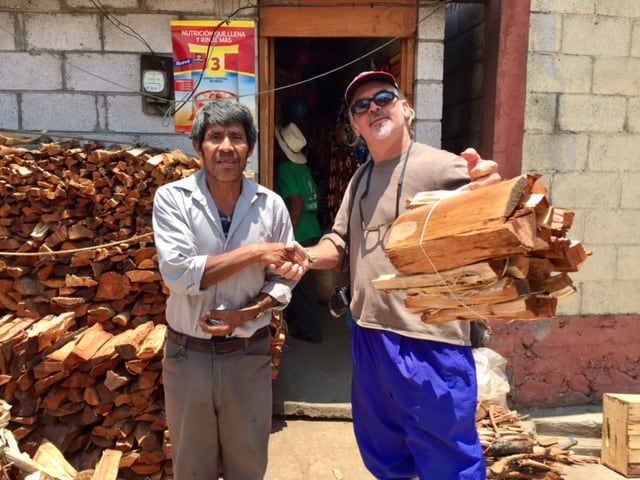
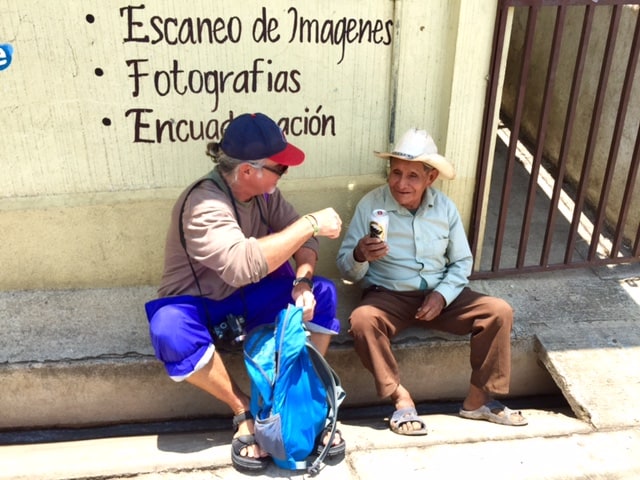
People speak Tz’utujil here – a Mayan language. It’s their primary language, and it’s fascinating to hear. It’s throaty with a lot of ‘clicking’ noises, and to my untrained ear, some ‘clucking’ sounds. Many younger people also speak Spanish. That’s a good thing because Tz’utujil is not in Google translate. English is rare to non-existent. But futbol (soccer) is universal.
San Pablo’s soccer field is just outside the main village area, on the road headed towards San Juan and San Pedro. Like so many soccer fields throughout Central America and Mexico, it did not have grass or turf. Just dirt, rock, and white powder for boundary lines. Another example of what life is like here for locals.
The police station is decorated with a mural of a woman and a girl in traditional Mayan dress. The mural reads, in Spanish and Tz’utujil: “Let’s keep our ancestral legacy.”
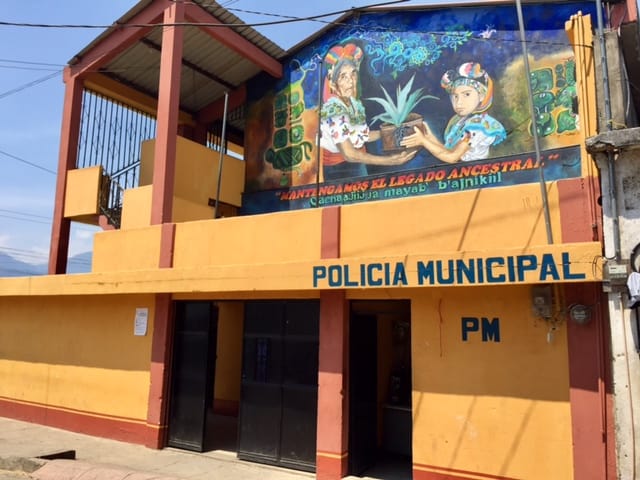
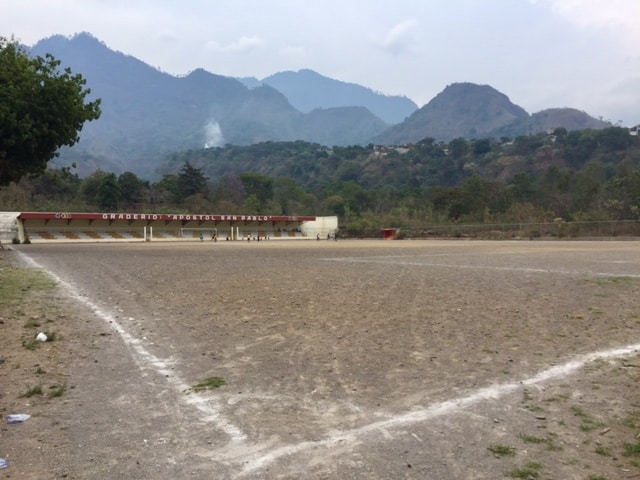
Most Maya people here are Catholic. The church was standing room only on Sundays, with an overflow of people listening to the service from the outside front steps. The church is across the street from a basketball court where older kids hang out. The police station is next to that court.
To sum it all up…
We never felt in danger, we never felt scared. There are many blogs and articles that advise tourists not to walk on the roads between the villages at night – for crime and for packs of dogs – a dog can have rabies here. I also met a few expats in Panajachel who warned against evening foot travel, so we didn’t do that. There was no need for that, anyway. We found just about everything we needed in San Pablo.
Our landlord is a kind man, and his beautiful family made us feel welcome. Their house is up a hill from our bungalow rental. There aren’t too many tourist rentals here – in fact, I know of only two Airbnbs where tourists could rent, plus one small place in the village that has a ‘hotel’ sign for a few rooms. It looks like an intimate place.
There is one yoga retreat center billed as a hermitage on the road leading to San Juan and San Pedro – but we never saw anyone who looked like they were patrons of that center wandering around in the village.
And that brings me to a couple of reasons why San Pablo is not a tourist mecca like some other villages.
One big reason: other villages have plenty of places for tourists to stay – a ton of Airbnb rentals, hotels, hostels. The living arrangements for visitors to San Pablo currently are scarce. That’s a good and bad thing, according to locals, and that brings us to the next reason: many people seem slow to change and accept to more tourists. Life is set here. It’s been this way for a long, long time. They live that saying in the mural – they are preserving their ancestral heritage.
Most locals thought we were staying in San Marcos, the next town to the east from San Pablo. It’s a big tourist attraction with yoga centers, dance ceremonies, organized tours, etc. When we told people we were staying in San Pablo – for a month – sometimes we got a blank look.
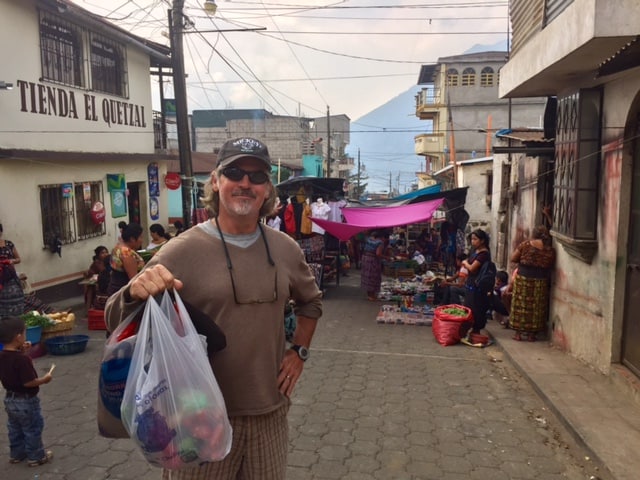
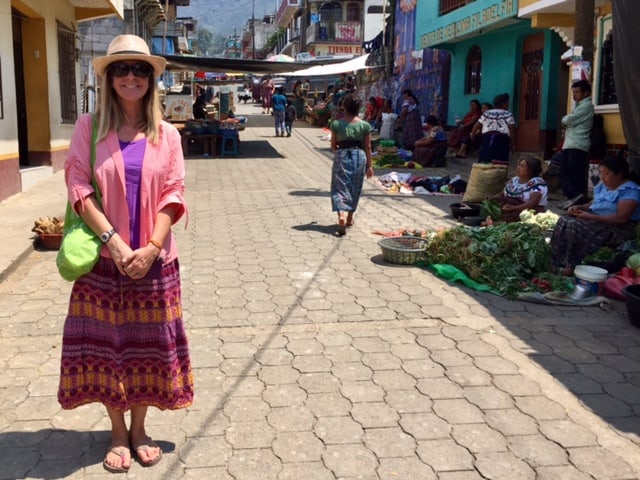
One older lady started a conversation with us as we walked by her home. It’s probably not too often that tourists walk by her home on that street – it’s a few blocks off the main road. She and her daughters tried to sell us a purse she had made. When we told her we would think about it, that we might return because we were staying many weeks in San Pablo, she look stunned.
‘We want tourists to come,’ said one man who practiced his English with us. We met him at the market one day. He was the only person in the village I ever heard speak any English. ‘We want people to see San Pablo is un buen lugar (good place) – a beautiful place.’ It’s just that tourists don’t come here too often, he said.
San Pablo has a ‘rough’ reputation. I am not sure why. Everyone was kind to us, everyone smiled back and had a greeting for us. It seemed people relaxed more when we explained we were just visiting – not moving in forever.
Another local man said more tourists in San Pablo would be both good and bad. The money would help the village, he said, but with more tourists come more problems. Isn’t that the truth.
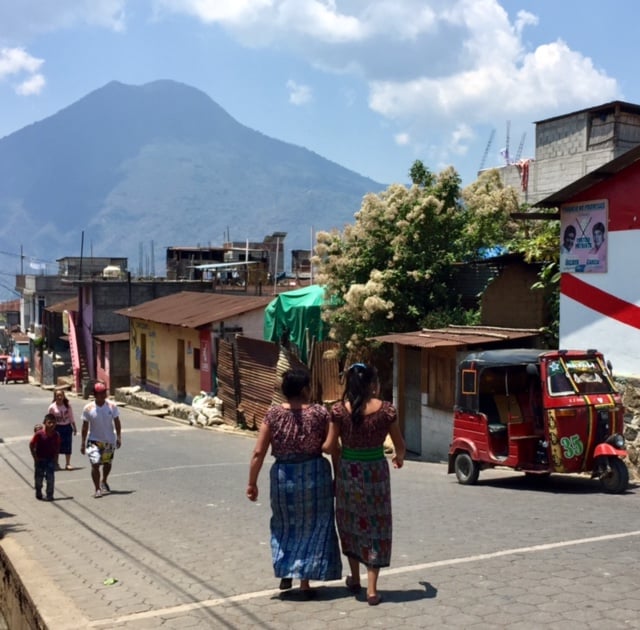
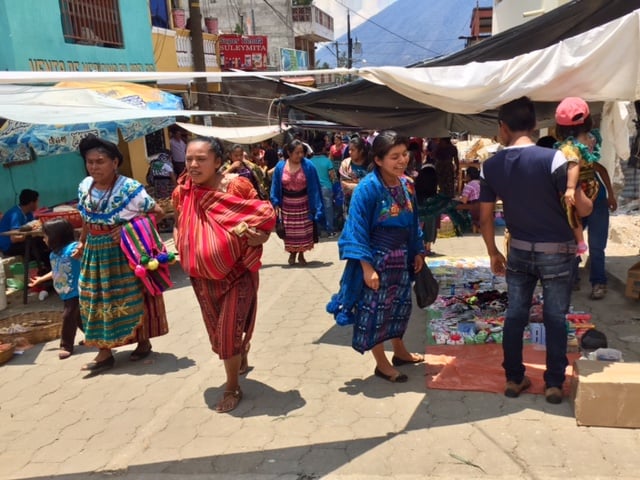
Sometimes I get sick of tourists. Visitors can be rude to locals, or simply ignorant of how hard life can be for the average Guatemalan worker.
Besides, I’m just not too interested in that cacao dance ceremony designed to separate tourists from their money, or what bar in town is offering a Sunday brunch special. I think it’s a gift to see how locals live, and to quietly live among them. This way, I can learn a little bit about another culture, and its different rhythmic approach to life. I experienced this a little when I lived in a working class Tulum neighborhood for five months, and when we rented an apartment away from the tourist zone in Puerto Vallarta for one month. Observation, new knowledge and experiences keep me grateful for my own life.
Now, after a quiet, peaceful and happy month in San Pablo, we will head to San Pedro for about two weeks. That village has a reputation for being the tourist party town on the lake. We’ll go check it out – variety is a good thing. Nothing is forever in this vagabond-style early retirement. In fact, we’ve begun to hatch a plan for new destinations in the year ahead. We have tentative stops on the globe that will take us through the fall of 2018. I’m excited about where in the world we will go next. And next. And next.
One more thing about Lake Atitlan in general. Some people believe dreams are affected by living at the lake. I had some crazy, vivid dreams many nights in the last month – way more than usual. So, there may be something to that. Despite the increased dream activity, I feel rested and I had great, long hours of sleep here.
Meanwhile, it’s none of my business on what happens to San Pablo’s future – more tourists or not. I only know it was perfect for me at the time I was here. So thank you, San Pablo. Thank you. Perhaps I will see you again.
The view of Lake Atitlan and Volcan San Pedro from our bungalow’s bedroom window.
*See a video tour of the bungalow we rented here.
🙂
Thanks for reading, “San Pablo la Laguna: Mayan village on Lake Atitlan with no tourists (besides us).”
You might also be interested in Thailand, Malaysia, Romania, Bulgaria, Turkiye, India, or other exotic countries on your budget slow travel adventure.
See our destinations page, and tap/click on the name of the country that interests you!

Hello! I’m so glad that I came across your article. It warms my heart to know how they preserve their culture. I find more hope, more peace in my heart. I know they will never regret this decision. My heart.. I just can’t contain my happiness.. I often said to myself before that if God will take away every thing from me, I can bear it. As long as He will place me in an area where simplicity can sustain.
Then, I am currently learning what ancient culture San Pablo has.. I know, I just know in my heart that they are doing the right thing.
And today, it is just like God is affirming me that this is the ‘place’.. This is His answer to my heart’s plea.. In case I have to give up everything this world is giving.
Thank you so much! From the deepest part of my heart, thank you for giving me the answer.
I know you, too, is getting all your heart’s desire.
Continues to inspire us with your stories, Mr. Theo and Ms. Ellen ❤️
Love your story on San Pablo. We aren’t near the traveler you are – hate to call ourselves tourists, but I supposed that’s an appropriate description. We stayed outside San Pedro (in a tree-house, so that’s kind of out there) in early February 2020 and made day trips around the lake. San Pablo was my favourite stop as it was simply an everyday ‘working class’ village. Your descriptions made me miss the Lake Atitlan region greatly!
Thanks so much, Jim! If you are able to enjoy the authenticity of San Pablo, we’d call you a fellow traveler! Happy trails 🙂
Great article! I’m actually now in San Pedro for 2 weeks and everyone has told me to stay clear of San Pablo as I’m trying to do a lot of running and from San Pedro to San Marcos is a great 10k to run to and back… after this article, I think I should be fine… worst case if i get stuck up (as everyone is warning me about) I will after all be running so hopefully outrun any bandits. Just curious if you heard about that as well? And specifically about San Pablo? (Also the road from San Pedro to the opposite direction, around San Pedro Volcano, I’ve been told is also dangerous).
Hello- I simply used common sense whenever I was alone along the road: didn’t carry much that was valuable, didn’t do it at night, etc. I did hear stories about problems, but I personally never experienced any issues. Have a great trip!